Considering Moonstone for Your Engagement Ring
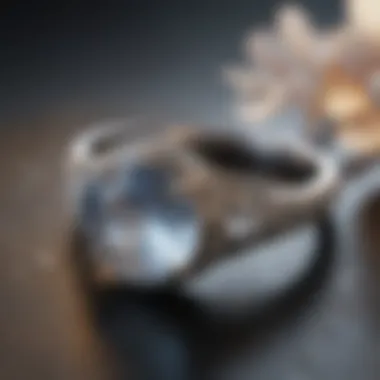
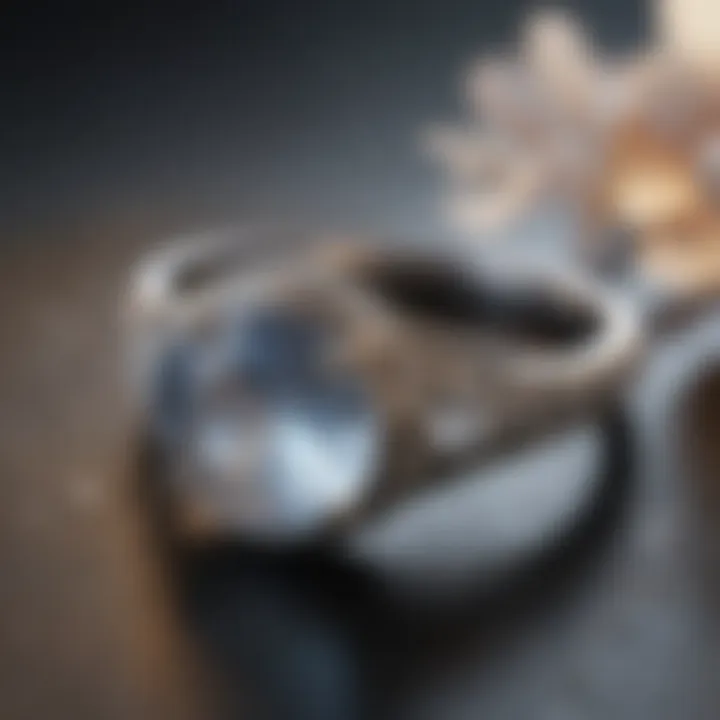
Intro
As the search for unique engagement rings continues to grow, many people are looking beyond the traditional diamond. One stone that has sparked interest is moonstone. Its captivating aura and soft glow provide an essence that appeals to couples wishing for something different. This article aims to consider moonstone from various angles, exploring its visual splendor, durability, cultural significance, and its metaphysical associations. Ultimately, it promises a detailed understanding of moonstone’s viability as a remarkable symbol of commitment.
Gemstone Overview
Definition and Characteristics
Moonstone is a captivating gemstone renowned for its adularescence—a phenomenon that creates the optical effect of a floating light across the surface of the stone. This unique light play gives moonstone a dreamy, ethereal appearance, often resembling the soft hues of a night sky. The stone comes in an array of colors, including clear or colorless, grey, blue, peach, and even rainbow moonstone, which features a blend of multiple colors through its body.
Classification of Gemstones
In the grand scheme of gemstones, moonstone belongs to the feldspar mineral group. It's classified as an orthoclase or microcline, which is significant given the diversity of gemstones derived from the feldspar family. Among gem enthusiasts, moonstone is categorized as a semi-precious stone, a distinction that reflects both its beauty and the perception of its worth, especially when compared to sparkling diamonds.
Properties of Gemstones
Physical Properties
When considering moonstone for an engagement ring, understanding its physical properties is essential. Here are some characteristics worth noting:
- Hardness: Moonstone ranks around 6 to 7 on the Mohs scale, signaling moderate durability. While it's harder than some gems, it's not as sturdy as diamonds.
- Luster: The stone possesses a vitreous to pearly luster, enhancing its visual appeal.
- Cleavage: Moonstone exhibits perfect cleavage in two directions, which can be advantageous in crafting but requires care in everyday wear.
Chemical Properties
On a chemical level, moonstone primarily consists of silicate and aluminum, which contributes to its shimmering effect. Its chemistry may not be the same as that of diamonds, but its unique composition yields an appearance that's striking in its own right. Additionally, moonstone is known for displaying phenomena such as labradorescence, which is sometimes observed in sweep of colors within certain varieties.
"Each gemstone tells a story, carrying with it the whispers of time and the tales of the earth from which it comes."
In essence, moonstone possesses a delicate charm and a history that is intertwined with various cultures, making it an attractive choice for engagement rings. It's important to consider how the stone’s characteristics align with personal preference and how it could stand the test of time.
The Allure of Moonstone
In considering engagement rings, it’s not just about the shine of the stone but also the story each gem tells. Moonstone, with its soft glow and intriguing depths, has captured the imagination of many. This section will delve into its visual characteristics and cultural significance, shedding light on why this particular stone could hold appeal for those seeking something distinctive and meaningful.
Visual Characteristics
Color Spectrum
Moonstone is notable for its depth of color. Often it showcases a spectrum ranging from clear to creamy whites, with flashes of blues and grays. This variety gives it a personality that can resonate with diverse styles and tastes. The color can shift depending on the light and the angle, providing an ever-changing display, much like the phases of the moon itself. This quality can be a significant draw for couples wanting something that feels alive and dynamic.
The key characteristic here lies in that ability for moonstone to evoke emotion through its color play. Whether one is drawn to a subtle blue sheen or the more common whitish hue, the colors can symbolize a range of sentiments, connecting deeply with the wearer's feelings and experiences.
However, this beauty comes with a caveat. The color can vary between stones, so choosing the right shade involves some care and attention, ensuring it aligns with personal taste.
Luster and Sheen
Another remarkable aspect of moonstone is its luster. This stone is famous for a soft, silvery sheen called adularescence, which occurs when light diffuses through layers of feldspar within the stone. This quality adds a velvety, almost ethereal glow that can be extraordinarily captivating.
The aesthetic appeal of moonstone's luster makes it an ideal choice for those looking for radiant yet understated elegance. In contrast to the intense sparkle of diamonds, moonstone offers a more serene form of beauty. However, because of its softer appearance, it may not attract attention in the same manner. This could be a drawback for individuals who prefer the more traditional glitz of engagement rings.
Unique Optical Effects
When discussing moonstone, it’s impossible to overlook its unique optical effects. The phenomena of labradorescence and schiller—a play of light that creates dazzling visual effects—enhances its allure. Each stone can display this lively dance of light in its way, resulting in a highly individualized piece of jewelry.
This characteristic makes moonstone a wonderful option for creative souls who appreciate artistry in their engagements. However, potential owners should keep in mind that these effects aren’t always consistent. Some stones may exhibit these effects more prominently than others, leading to variations in visual impact.
Cultural Significance
Mythological Origins
Historically, moonstone has been linked to various mythologies around the world. Its Greek roots tie it to the lunar deity, further cementing its celestial connection. The stone is often seen as a symbol of passion, creativity, and the duality of love—traits that resonate well with couples embarking on the journey of engagement.
Considering moonstone's mythological significance offers a compelling reason to choose it. Such deep roots can provide a kind of bond between the wearer and the story behind the stone.
Historical Uses in Jewelry
In terms of historical usage, moonstone has graced the crowns and scepters of royalty across multiple cultures. It has been utilized in various forms, from ancient Roman jewelry to Victorian art pieces. This history adds a layer of intrigue, imbuing the stone with a sense of timelessness and continuity—a narrative that aligns well with the notion of enduring love.
However, its historical charm does come with challenges, as it may not evoke the same immediate recognition as diamonds do today, possibly complicating its perception in modern contexts.
Modern Interpretation
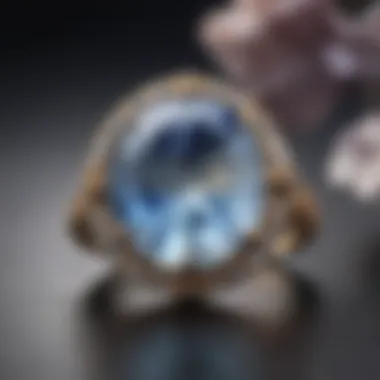
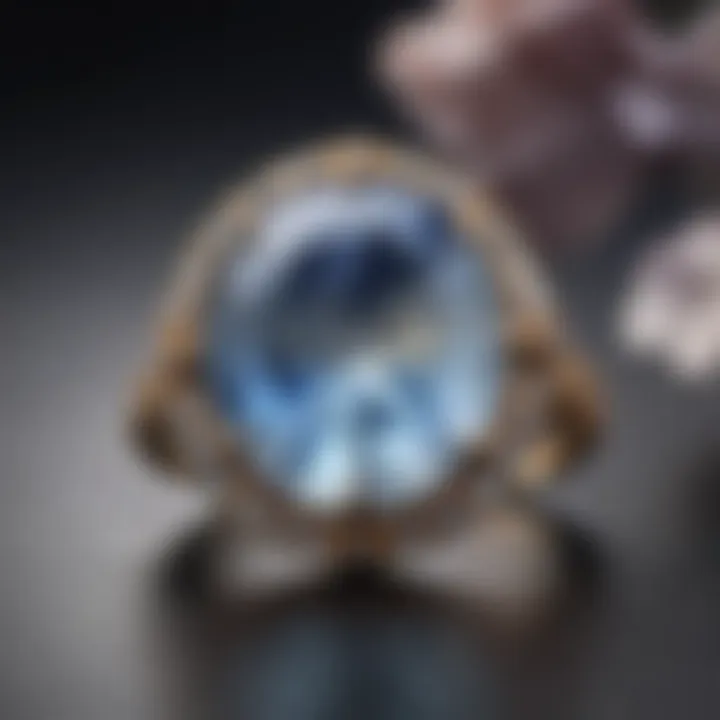
In contemporary society, moonstone is increasingly embraced as a means of self-expression. Many modern couples lean toward non-traditional stones, seeking to tell their own love story. Moonstone fits perfectly in this narrative, allowing individuals to display their uniqueness.
While it offers a fresh perspective, potential buyers should be aware of the societal tendency to associate engagement rings predominantly with diamonds. This incongruity could either be a disadvantage or an opportunity to forge a unique identity in terms of personal value in gems.
Understanding the allure of moonstone is not just a matter of aesthetics but is steeped in cultural and emotional significance, making it a gem that resonates far below the surface.
Comparing Moonstone to Traditional Options
When it comes to engagement rings, the choice of gemstone is crucial in expressing both personal style and underlying sentiment. Moonstone serves as an intriguing alternative to the classic diamond, stirring up questions about its appropriateness for such a significant symbol of commitment. Understanding how moonstone measures up against traditional options is vital in making an informed decision. This section will delve into the unique aspects of moonstone, juxtaposing it with diamonds and other alternative gemstones, while examining facets such as rarity, cultural expectations, and overall value.
Diamonds versus Moonstone
Rarity and Value
Rarity plays a big role in how we perceive value, especially when it comes to gemstones. Diamonds are often viewed as the gold standard, known for their scarcity and high demand. A main draw for diamonds is их established market value; some folks even see them as an investment.
In contrast, moonstone offers a refreshing shift. While it may not have the same price tag, its uniqueness stands out. Many people find moonstone's physical beauty compelling, with its ethereal glow and soft coloring offering something distinctly different from the traditional bling of a diamond. So, for those who value originality over conventionality, moonstone can be an appealing option.
However, the question of value inevitably connects back to societal norms. Diamonds, regardless of their market performance, have a conspicuous cultural status. As a result, choosing moonstone might not fit traditional narratives of value, however, many argue that true worth comes from individual taste, not just what the market dictates.
Cultural Expectations
Cultural expectations create a formidable backdrop in the conversation about engagement rings. Diamonds have long been enshrined in popular culture as the ultimate symbol of love and commitment. This perception permeates various media, from classic movies to contemporary social media influencers, continuously reinforcing the notion that "the bigger the diamond, the better."
Moonstone, however, beckons those willing to challenge these norms. Its connection with intuition and emotional clarity makes it a captivating choice. While cultural expectations favor diamonds, moonstone offers a sort of quiet elegance that can symbolize a new, modern approach to commitment. For couples looking to forge their own path, moonstone provides the opportunity to embrace a stone that’s not only beautiful but resonant with personal meaning. This divergence leads to a more authentic representation of the relationship.
Resale Value Considerations
When discussing gemstone choices, resale value often crops up. Diamonds usually win this battle; they have a well-established market and are well-regarded as luxury items. In many scenarios, diamonds can hold or even appreciate their value over time, making them a sensible financial choice.
On the other hand, moonstone doesn’t carry the same resale value. Its fluctuations in market demand mean that owners might not recoup their initial investment. Nevertheless, it’s essential to consider the intrinsic value that moonstone brings to engagement. The emotional and aesthetic appeal can outweigh financial considerations for many individuals. Moreover, sentimental value can often be far greater than any resale figure.
Other Alternative Gemstones
As alternative engagements grow in popularity, sapphire, emerald, and opal have emerged as noteworthy contenders alongside moonstone. These gemstones appeal to various tastes and desires, each offering something unique in terms of symbolism, beauty, and durability.
Sapphire
Sapphires evoke a certain prestige. Known primarily for their deep blue hues, they offer durability and elegance. With a hardness rating of 9 on the Mohs scale, sapphires stand up well against wear and tear. Their history in royalty adds to their allure, often seen as a symbol of wisdom and nobility. Yet, unlike moonstone, sapphires are a bit more mainstream, which could be both an advantage or disadvantage depending on what one wants.
Emerald
Emeralds are celebrated for their lush green beauty. Revered for thousands of years, these stones signify rebirth and love. They rank lower than sapphires on the hardness scale, at 7.5 to 8, which can impact their suitability for an everyday ring. However, their rich hue certainly captivates attention, adding an exotic flair to any engagement ring. Just like sapphires, they are more standard than moonstone, potentially losing some uniqueness.
Opal
Opals charm with their play-of-color, captivating those enchanted by light and vibrancy. Unlike the straightforward beauty of diamonds or sapphires, opals have this elusive characteristic. They’re delicate, with a hardness of about 5 to 6.5, making them less ideal for daily wear. However, they resonate deeply with some due to their multi-dimensional colors and ethereal presence. Like moonstone, opal genderfies conformity, offering a distinctive choice for the unique lover.
Ultimately, the comparison between moonstone and more traditional engagement choices highlights a fundamental shift in values. It encourages, if not demands, a reevaluation of what significance looks like in gemstones.
Durability and Maintenance
When considering moonstone for an engagement ring, it’s essential to address durability and maintenance. Rings are worn daily, and their longevity hinges on how well they hold up to life’s wear and tear. Moonstone, though beautiful, comes with its own set of characteristics that affect its durability and how one should care for it. Understanding these factors can significantly aid potential buyers in making an informed decision.
Mohs Hardness Scale
Understanding Durability
Durability is like the backbone of any gemstone choice, and it ties directly into how well a stone can stand the test of time. Moonstone sits at about 6 to 7 on the Mohs scale, which tells us a bit about how resilient it is against scratches and impacts. While not as hard as diamonds, its moderate durability makes it suitable for someone who leads a slightly adjusted lifestyle, being careful not to subject the ring to extreme force.
That said, it’s crucial for buyers to know that this stone can still chip or crack under undue pressure. One unique feature is that the way light interacts with the stone—the blue sheen—remains captivating even if there are minor imperfections, but this doesn’t mean that one should intentionally mishandle it. For couples who value the spiritual connection and emotional significance of the gem, understanding its qualities also adds depth to their choice.
Impact on Wearability
When diving into wearability, that’s where things can get tricky. Moonstone rings need some TLC. Because of its relative softness compared to options like diamond, it's recommended to treat the ring as a cherished item rather than an everyday piece. If you’re the type who works with your hands or engages in rigorous activities, know that opting for a moonstone might require some adjustments in lifestyle. It’s about finding balance; you’ll want to enjoy the beauty and meaning of the stone without living in constant worry of damaging it.
Just remember, keeping it in a fabric-lined box away from other rings can help prevent those unfortunate scratches.
Comparison to Other Gemstones
When stacking moonstone against other popular choices, like sapphire or ruby, durability becomes a hot topic. Sapphires boast a solid 9 on the Mohs scale, making them far more practical for daily wear. However, speaking of its unique tone and iridescence, moonstone requires a special kind of appreciation that transcends mere hardness ratings. This uniqueness is what draws many to it, knowing that each stone is one-of-a-kind—never to be replicated.
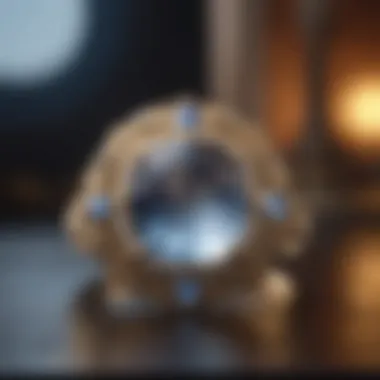
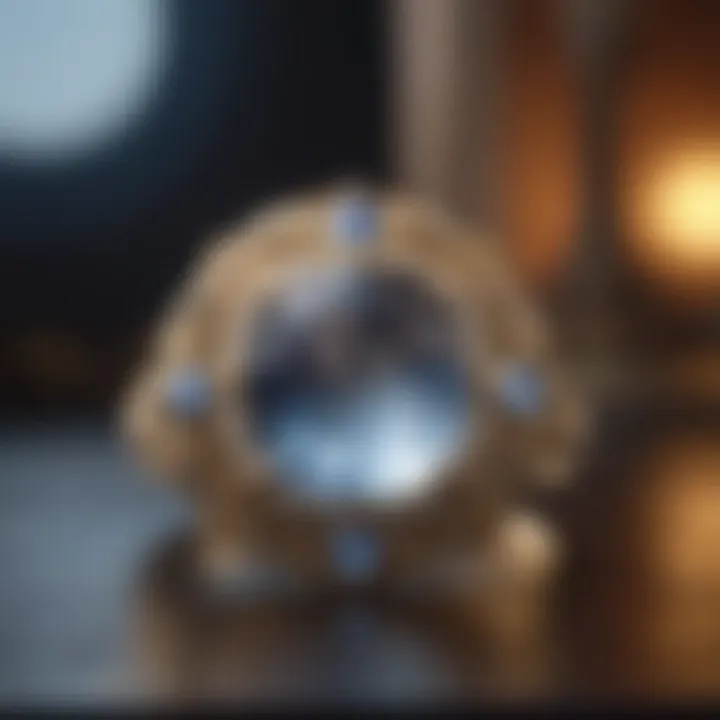
If you prioritize durability above all, moonstone might not seem like the best bet. But if you’re after emotional resonance and individuality, then this is a stone worth considering, despite its lower hardness.
Care Guidelines
Cleaning Techniques
Keeping a moonstone dazzling does require attention. Cleaning techniques are pivotal in maintaining its luster. A simple solution can be warm water combined with gentle soap. Gently scrub with a soft cloth. What's key here is to avoid harsh chemicals or ultrasonic cleaners, as they can damage the stone. This light cleaning approach not only guards the stone but also keeps its radiant sheen intact.
Storage Recommendations
When it comes to storage, moonstone requires a bit of extra thought. Ideally, store your moonstone ring away from other pieces of jewelry. Using a padded box or a soft pouch can help avoid scuffs or bumps. Remember, moonstone is particularly vulnerable to scratches from harder gemstones, so exercise caution when it shares space with other rings.
Regular Maintenance Tips
Finally, adopting regular maintenance tips is a sensible approach. Have the ring inspected by a jeweler annually, not just for cleanliness but also for structural integrity. This helps catch any potential issues early on. Pair that with periodic polishing—handled correctly, it can help maintain its stunning appearance. Forming good care habits from the get-go can enhance longevity, ensuring you enjoy your moonstone ring for many years.
In the world of engagement rings, the choice shouldn’t solely revolve around the gemstone’s physical attributes; emotional significance and personal connection play a gigantic role as well.
Overall, keeping durability and maintenance in mind can vastly improve your experience with a moonstone engagement ring. It may require a bit more attention, but the rewards of showcasing such a unique and meaningful gem can far outweigh these considerations.
Symbolism and Meaning of Moonstone
Moonstone has long captivated those who seek not just beauty but depth in their jewelry. Choosing moonstone for an engagement ring isn't simply a matter of preference; it represents a journey into symbolism steeped in emotion and cultural significance. The connotations that surround moonstone are rich and diverse, providing a unique perspective on love and relationships. Understanding these meanings can help individuals choose a stone that resonates not only with their aesthetic sensibilities but also their values and beliefs.
Emotional Significance
Representation of Love
When people speak of moonstone and its representation of love, they're often referring to its soothing and nurturing qualities. This gemstone is thought to foster a deep emotional connection, something that many seek in a union. Moonstone's captivating glow is likened to the gentle embrace of a loved one, symbolizing a bond that glows in the darkness. Choosing moonstone as an engagement ring can signify the fragility and beauty of love, reminding the wearer that love, like a moonlit night, can be both serene and profound.
Its unique feature lies in its ability to project kindness and compassion, making it a well-suited choice for a relationship focused on understanding and empathy. However, one must also consider potential drawbacks. While moonstone offers emotional significance, it might not carry the same weight as traditional gemstones like diamonds in cultural expectations.
Intuition and Clarity
The aspect of intuition and clarity associated with moonstone adds another layer to its symbolic nature. People often say that moonstone enhances emotional intelligence, lending clarity when navigating relationships. It encourages introspection and honesty, making it a popular choice for couples who value open communication and understanding. The soft, reflective quality of moonstone is reminiscent of a calm mind, promoting serenity in decision-making.
One of its key characteristics is that it can help individuals connect with their instincts. Yet, the somewhat ethereal nature of moonstone also poses a challenge; its lack of inherent hardness can be seen as a metaphor for vulnerability. Couples looking for strength may need to weigh these attributes against their needs.
Connection to New Beginnings
The symbolism of new beginnings that moonstone embodies can resonate deeply with couples embarking on their journey together. Just as the moon goes through its phases, moonstone signifies transitions and the cyclical nature of life. It is associated with renewal and freshness, essential traits for any relationship hoping to grow and evolve.
Its unique aspect of indicating change can be beneficial for those seeking an engagement ring that reflects the excitement of the future. However, some might find the connection to new beginnings also denotes uncertainty, which can be daunting. Knowing this can help couples contemplate whether this sentiment aligns with their future aspirations.
Cultural Interpretations
Different Regional Beliefs
In various cultures, moonstone holds unique meanings, reflecting a plethora of beliefs and traditions. For instance, in India, it is considered a sacred stone, embodying the spirit of love and harmony. Various regional beliefs highlight moonstone’s association with femininity and intuition, making it a sought-after gemstone for many brides. This variety in cultural interpretations widens its appeal significantly.
Choosing moonstone, however, also brings the need to navigate these different beliefs. While some view it solely as a stone of love, others might see it through a more spiritual lens. This can create a complex dynamic for couples who want to honor their unique backgrounds in their choice of an engagement ring.
Moonstone in Various Cultures
Moonstone's presence across various cultures tells a story threaded through time. From ancient Romans who believed moonstone was formed from solidified moonlight to Polynesian cultures that regard it as a talisman for good fortune, the stone's lore adds depth to its allure. This makes moonstone not just a piece of jewelry but a conversation starter, connecting wearers to a larger narrative that spans numerous cultures.
The disadvantage of this broad cultural significance, however, is the potential dilution of personal meaning. For some, finding their narrative among assorted interpretations might prove challenging—especially when trying to choose a ring that resonates personally.
Astrological Associations
Astrologically, moonstone is often linked to the moon and is particularly significant for those born under the Cancer sign. It represents feminine energy and is thought to stabilize emotions while enhancing intuition. Many people who resonate with astrological elements might find it appealing to wear a stone that aligns with their celestial bodies.
This connection can serve as a comforting reminder of the natural world and its influences on our lives. However, not everyone may find these associations relevant, leading them to prefer more universally recognized symbols in their choice of gemstones.
"The moonstone is more than just a stone; it's a bridge between moods and emotions, a reflective surface of love and intuition, layered in rich cultural history."
In summary, the symbolism and meaning of moonstone are entrenched in its emotional significance and cultural interpretations. Choosing moonstone can be a meaningful decision for those who appreciate its depth. However, it's essential to weigh these attributes against personal beliefs, cultural backgrounds, and the relationship's direction.
Considerations for Choosing Moonstone
Choosing an engagement ring is no small feat, especially when considering a unique stone like moonstone. It’s essential to weigh various factors that contribute to the overall appeal and practicality of this gem. Understanding how moonstone fits into the grand scheme of engagement rings can help make an informed decision. Here are some vital considerations that you might want to ponder upon as you contemplate this radiant stone.
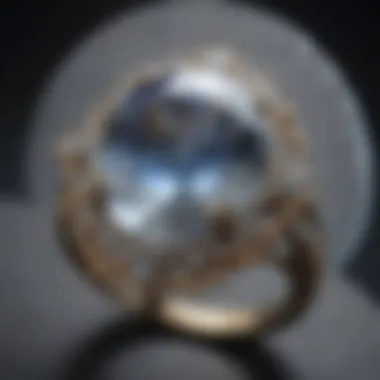
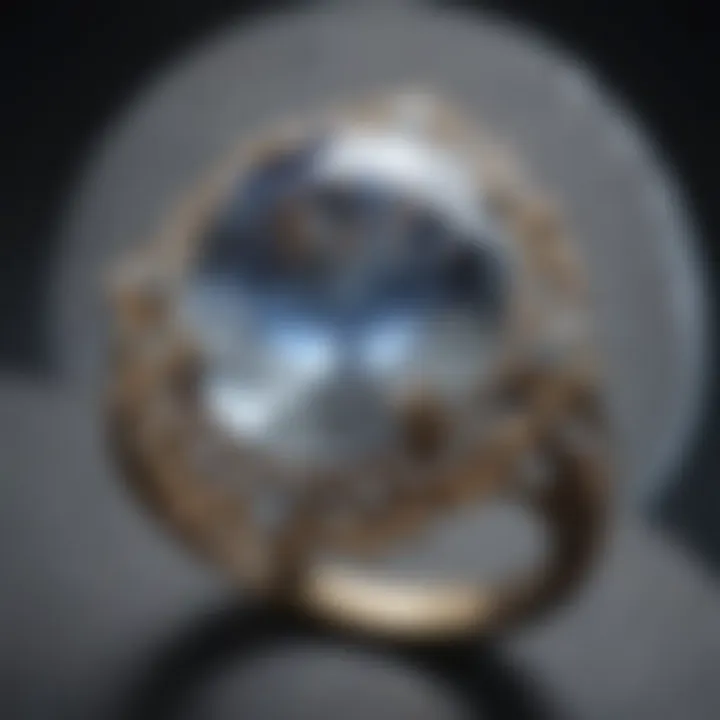
Quality and Grading
Understanding Clarity and Color
When embarking on the journey of selecting moonstone, the clarity and color should take center stage. Unlike your standard diamonds, moonstones are treasured more for their captivating play of color than for their clarity alone. The key characteristic to keep an eye on here is the depth and intensity of hues. A top-quality moonstone may exhibit a rich blue sheen against a clear backdrop, while others could display more muted or varied colors, which may offer a distinct charm but might not fit everyone's taste.
The unique feature about clarity is that while high clarity may be desirable, a bit of inclusions can sometimes add character and uniqueness to the stone. One advantage is that moonstone generally maintains a softer appearance, inviting a more casual, bohemian appeal that many find irresistible.
Assessing Cut and Shape
Cut and shape also play a crucial role in enhancing the stone's aesthetic appeal. The way moonstone is cut can greatly affect its ability to reflect light and showcase its distinctive sheen. A well-executed cut can amplify that enchanting adularescence—where the light seems to move beneath the surface—creating a mesmerizing effect.
Consider that the key characteristic here is how the cut influences the stone's radiance. For example, a cabochon cut is often favored for moonstone, as it accentuates the optical phenomena better than other shapes might. However, this choice might not be conventional for an engagement ring, as many prefer faceted stones. Thus, the advantage of a cabochon is its uniqueness, while the disadvantage may lie in its practicality, as it’s more prone to scratches.
Importance of Certification
When selecting moonstone, especially for something as significant as an engagement ring, certification cannot be overlooked. Having a certified gem not only assures the quality but also signifies that the stone has been analyzed for authenticity and grading. Certified stones can often command higher respect and value in the market.
The key characteristic of certification is its role in verifying the stone's quality. A reputable gemological institute can also assist in assessing the stone's unique selling points, which is crucial for customers. One disadvantage, however, can be the additional costs associated with certification; yet, in the long run, it is usually a worthwhile investment for peace of mind.
Personal Preferences
Choosing Based on Aesthetics
Choosing a moonstone engagement ring often comes down to personal aesthetics. The beauty of moonstone lies in its soft, ethereal glow, which can contrast sharply with the glitter of more traditional gems. Individuals who lean towards a dreamy and romantic style may find that moonstone resonates perfectly with their sense of beauty.
The key characteristic here is the romantic appeal that moonstone brings. With its gentle hues and shifting colors, many feel it tells a story unique to each relationship. But it is essential to recognize that aesthetic preferences can be quite personal; what sings to one could fall flat for another. Not everyone may find moonstone's understated charm captivating, which can be seen as a disadvantage if aiming for broader appeal.
Influence of Emotional Connection
The emotional weight tied to a piece of jewelry can play a significant role in the decision-making process. A moonstone can evoke feelings of introspection, emotional healing, and connection due to its metaphysical properties linked to love and intuition. This emotional bond cannot be ignored when choosing a stone for an engagement ring.
The key characteristic of choosing moonstone is its association with new beginnings and emotional clarity. Couples who resonate with these meanings might find moonstone a perfect fit. However, it's important to note that not everyone subscribes to such beliefs, which can be a potential hurdle if one’s partner prefers a more traditional or universally recognized representation of commitment.
Impact of Trend and Fashion
Lastly, one cannot ignore the influence of current trends and fashion in the gemstone arena. Moonstone has seen a resurgence in popularity, especially among young couples seeking something different from the typical diamond. Its vintage feel and retro-modern charm make it a great choice for those wanting to stand out.
The key characteristic here is the shifting nature of trends; while moonstone may thrive in popularity right now, who knows what the next few years might bring? A moonstone engagement ring could serve as a beautiful representation of personal style, but it also runs the risk of changing in perception over time. This aspect can be viewed as a double-edged sword—exciting yet unpredictable.
"Ultimately, the choice of a moonstone engagement ring should be as unique as the love it represents. It’s advisable to weigh all options while embracing a personal narrative that echoes one's authenticity."
Final Thoughts on Moonstone Engagement Rings
Choosing moonstone as an engagement ring is a decision steeped in individuality and reflection. It captures both an aesthetic appeal and a deeper cultural significance that resonates with many. As readers navigate this article, it becomes clear that moonstone is an evocative gemstone, rich in history and meaning. It stands as a unique option amidst more conventional choices like diamonds, but it comes with its own set of considerations.
Pros and Cons Overview
Benefits of Choosing Moonstone
Moonstone offers an enchanting beauty characterized by its adularescence, where colors shift depending on the angle of light. This feature gives it a magical quality, distinct from the uniform sparkle of diamonds. Furthermore, moonstone is often associated with new beginnings, making it an ideal symbol for the start of a marriage or partnership. Its affordability compared to higher-end gemstones means couples can opt for larger stones or elaborate settings without breaking the bank. This accessibility makes it a popular choice for those who seek something different yet equally meaningful.
Challenges to Consider
While moonstone's beauty and symbolism are alluring, there are practical challenges. One major issue is its relative softness on the Mohs scale, rated between 6 and 7, which may not withstand daily wear as well as harder stones like sapphires or diamonds. This can result in scratches and a need for more diligent maintenance. Buyers should also be aware that moonstone may not hold its value as well as traditional gemstones, which could impact long-term decisions regarding resale or heirloom quality.
Long-term Considerations
When selecting a moonstone engagement ring, thinking long-term is crucial. The emotional connection to the stone often supersedes its market value, but it is essential to consider how the stone will age with daily wear. Moonstone requires a bit more care; it should be kept away from harsh chemicals and cleaned gently. For those who prioritize emotional resonance over conventional standards, moonstone’s unique qualities could close the gap. However, should durability become a concern, it may be wise to consider alternate stones that can withstand the rigors of everyday use while preserving the sentimental value.
Personalizing Your Ring
Design Options
Moonstone offers an array of design possibilities due to its versatile color and luster. Jewelers can set it in a myriad of styles, from vintage-inspired to contemporary looks. The stone’s unique qualities allow it to shine in various settings, giving buyers the chance to craft something truly one-of-a-kind. From simplicity to intricate, artistic designs, the creative options are virtually limitless. Custom designs can help embody personal stories, making the engagement ring even more special.
Combining with Other Stones
For those who want to add more depth to their ring, combining moonstone with other gemstones creates a striking contrast. Pairing it with complementary stones like diamonds, sapphires, or even vibrant-colored gemstones diversifies the look and enhances its visual storytelling. The contrast of colors and textures can breathe new life into traditional styles, offering a refreshing take on engagement ring aesthetics.
Unique Customization Ideas
When it comes to personalizing a moonstone engagement ring, creativity knows no bounds. Consider engraving initials, dates, or even a special message inside the band. For a distinct touch, custom band shapes or integrating motifs that hold personal significance can turn a beautiful ring into a narrative piece. These unique customization ideas not only enhance the ring's superficial beauty but also deepen its symbolic value for the wearer and their partner.
Ultimately, an engagement ring should embody the couple's story, values, and connections. Moonstone, with its ethereal charm, offers a refreshing alternative that invites contemplation beyond the conventional.
In summary, moonstone presents a unique canvas for expression, allowing couples to showcase their individuality and create something lasting. It holds both promise and challenges, encouraging those who choose it to reflect on what they hope their engagement ring represents.



